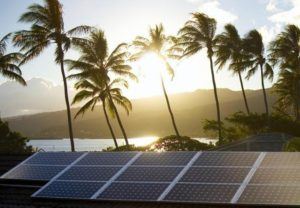Ohana Means Family: Learning to Share Resources Sustainably

Tackling sustainable energy production on resource constrained islands
Imagine you’re hanging out on the beach, enjoying a nice lilikoi shave ice or snacking on a spam musubi. Life’s good. Not much to worry about, right? Actually, if you’re Hawaiian Electric Industries (HEI), you’ve got a lot to think about because you supply 95% of Hawaii’s residents with electricity [1]. You help Waiola Shave Ice freeze their ice. You keep the gas station’s lights and warming oven going so those spam musubis stay warm. Without HEI (or a good backup generator), grocery stores and homes can’t store food. Important hospital equipment stops running.

Operating an electric utility is a lot of work but operating on a chain of islands comes with additional challenges. HEI has isolated electrical systems on each island that aren’t connected to each other or to any other electrical grid [2]. This means HEI needs to maintain a higher level of reserve generation than typically carried by mainland utilities, which can share reserve capacity with each other [3]. Most of this electricity comes from non-renewable sources that HEI imports, such as oil or coal [4]. However, in response to growing concerns about climate change, the State of Hawaii passed legislation in 2015 requiring electric utilities to switch to 100% renewable energy production by 2045 [5]. HEI faces significant operational challenges and risks as it explores various renewable energy technologies. Fortunately, due to the high cost of importing fuel, HEI is uniquely positioned as an electric utility with a significant cost advantage to producing renewable energy relative to other providers. This commitment to renewables could also make HEI a magnet for innovative thinkers and allow HEI to tap into a strong talent pool.

Building up all that renewable production capacity will require significant investments in new technologies and infrastructure. Compounding the challenge, Hawaii’s population is projected to increase from 1.4 million people in 2010 to 1.7 million in 2040, which may drive up total electricity demand [6]. As climate change causes global temperatures to rise, Hawaii can expect to get significantly warmer (up to a 9.4°F increase by the end of the century) [7]. Hawaii enjoys average daytime temperatures of 78°F to 85°F [8]. Higher average temperatures, especially in the summer, will also push overall demand and peak capacity needs up as people turn on their air conditioning more often. To mitigate the burden of higher demand on the existing power grid, HEI has encouraged consumers to save energy and install solar panels on their homes [9]. HEI has been proactive about taking steps to keep the transition to renewables smooth by reducing stress on the grid.

In addition to balancing supply and demand as HEI switches to renewable energy, HEI needs to take additional steps to ensure the new sources of production truly are renewable. Converting fuel into electricity requires water, with different methods resulting in different levels of water consumption [10]. HEI’s oil and coal fueled plants rely on traditional thermoelectric power station cooling, which use between 250 and 800 gal/MWh [11]. Certain types of renewable energy (e.g. biofuels, geothermal, nuclear) require much more water than this, while others (e.g. solar PV, wind) require virtually no water [12]. HEI is already experimenting with using recycled graywater at some of its facilities, which has the added benefit of reducing operating costs because graywater does not need demineralizing [13]. As HEI responds to increased demand and shifts to new production technologies, it must continue to look for ways to use water thoughtfully and sustainably. Of course, it takes electricity to pump groundwater and treat waste or saltwater. HEI needs to carefully consider which sources of renewable energy make the most sense from a net cost perspective as well as a sustainability perspective.

Hawaii is expected to see a significant rise in sea levels as a result of climate change [14]. This will raise the fresh water table, turning existing groundwater wells brackish and reducing the total supply of fresh groundwater [15]. As temperatures rise, agriculture may need more water for crop and livestock needs, exacerbating the water shortage. As demand for water increases, Hawaii will find itself in a tough spot. This is an island chain located thousands of miles from the nearest land mass – there are no backup sources of water other than what can be found on the islands (rainwater, surface water, groundwater, and reclaimed water) [16]. As HEI transitions into 100% renewables and responds to the impacts of climate change, HEI will need to take special care to use resources thoughtfully and share them with all of the other people living on the islands. After all, “ohana means family and family means no one gets left behind” [17].

(775 words)
Sources
- Hawaiian Electric Company, Inc.. 2016. Hawaiian Electric Company, Inc.. [ONLINE] Available at: https://www.hawaiianelectric.com/about-us. [Accessed 4 November 2016].
- Ibid.
- Hawaiian Electric Industries, Inc.. 2015. Form 10-K for FY 2015. [ONLINE] Available at: https://www.sec.gov/Archives/edgar/data/46207/000035470716000128/a201510k.htm. [Accessed 4 November 2016].
- Ibid.
- Ibid.
- Hawaii Department of Business, Economic Development and Tourism . 2012. Population and Economic Projections for the State of Hawaii to 2040 . [ONLINE] Available at: http://files.hawaii.gov/dbedt/economic/data_reports/2040-long-range-forecast/2040-long-range-forecast.pdf. [Accessed 4 November 2016].
- The Risky Business Project. 2014. Risky Business: The Economic Risks of Climate Change in the United States. [ONLINE] Available at: http://riskybusiness.org/site/assets/uploads/2015/09/RiskyBusiness_Report_WEB_09_08_14.pdf. [Accessed 4 November 2016].
- Hawaiian Electric Industries, Inc.. 2014. 2014 Corporate Sustainability Report. [ONLINE] Available at: https://www.snl.com/interactive/newlookandfeel/1031123/2014_Sustainability_Report.pdf. [Accessed 4 November 2016].
- Hawaii Tourism Authority. 2016. Hawaii Weather. [ONLINE] Available at: http://www.gohawaii.com/statewide/travel-tips/weather/. [Accessed 4 November 2016].
- Mielke, Erik; Anadon, Laura Diaz; and Narayanamurti, Venkatesh . 2010. Water Consumption of Energy Resource Extraction, Processing, and Conversion. [ONLINE] Available at: http://belfercenter.ksg.harvard.edu/files/ETIP-DP-2010-15-final-4.pdf. [Accessed 4 November 2016].
- Ibid.
- Fukunaga & Associates, Inc.. 2010. Hawaii County Water Use and Development Plan Update. [ONLINE] Available at: http://files.hawaii.gov/dlnr/cwrm/planning/wudpha2012.pdf. [Accessed 4 November 2016].
- The Limtiaco Consulting Group. 2013. 2013 Update of the Hawaii Water Reuse Survey and Report. [ONLINE] Available at: http://files.hawaii.gov/dlnr/cwrm/planning/hwrsr2013.pdf. [Accessed 4 November 2016].
- The Risky Business Project. 2014. Risky Business: The Economic Risks of Climate Change in the United States. [ONLINE] Available at: http://riskybusiness.org/site/assets/uploads/2015/09/RiskyBusiness_Report_WEB_09_08_14.pdf. [Accessed 4 November 2016].
- U.S. Geological Survey. 2014. Coastal Groundwater Systems. [ONLINE] Available at: http://wh.er.usgs.gov/slr/coastalgroundwater.html. [Accessed 4 November 2016].
- Ibid.
- Lilo & Stitch, 2002. [DVD] DeBlois, Dean; Sanders, Chris, United States: Walt Disney Feature Animation.



Jina, thanks for a very interesting post. Climate change discussions, as with other issues, tend to focus on large economies. They rarely go in depth of the special challenges, beyond rising sea levels, that islands face. It was inspiring to read that Hawaii has set a 100% renewable energy goal to Hawaiian Electric Industries by 2045. I agree that since fuel import is extremely costly for remote islands, like Hawaii, they are better situated to lead innovation and develop new renewable technologies. One such new technology I think islands can especially benefit from is Wave Energy. Several such technologies have been proposed and some already tested for capturing the energy from waves. These technologies vary on different dimensions such as location (e.g. on-shore and off-shore), orientation to the waves and so on. See the Bureau of Ocean Energy Management for additional information about Wave Energy https://www.boem.gov/Ocean-Wave-Energy/ . Although this technology is still in its infancy in terms of commercial use it might hold significant opportunities for locations such as Hawaii.
Totally agree Rotem. The US Navy also agrees with you! The first wave powered electricity to feed into a power grid happened in Hawaii! [1] The Navy is coordinating with the University of Hawaii to pioneer wave technology but as you mentioned, the technology is still in its infancy and it seems like it’s at least 5-10 years from commercial viability. Still, I’m hopeful that this could work out in Hawaii’s favor. Wave technology also has the advantage over solar and wind in that it’s not constrained by when the sun shines or wind blows but is effectively 24/7.
[1] Phys Org. 2016. America’s first wave-produced power goes online in Hawaii. [ONLINE] Available at: http://phys.org/news/2016-09-wave-produced-electricity-online-hawaii.html. [Accessed 7 November 2016].
I think you highlighted a good point in that importing fossil fuels (90% of which is oil) for power generation is not sustainable – electricity prices in Hawaii are amongst the highest, and relying on external supplies places the communities at risk. Hence renewables not only make sense in terms of reaching targets, but it also reduces the overall risk of the grid.
One thing that would be interesting to know is the mix of renewable resources available and consumption habits of people / industry on the different islands as matching the types of renewable energy to consumption needs will be critical – for example, if people use a lot of air conditioning in the evening, then solar alone will not be sufficient. In principle, it would be good to see a good mix of reliable power (dammed-hydro, geothermal, and nuclear) and peaking power (solar and wind) that matches consumption habits. Without a stable mix, it will unfortunately be difficult for any utility to become 100% renewable (unless battery technology improves to the point where it is able to store sufficient energy to match generation and consumption needs).
Hi Jina – extremely insightful post on a small island system. Any electricity system, be it small or large, will need to play around with demand and supply. This mismatch of demand and supply throughout the day makes utilities have large underutilized assets for peak demand periods. Luckily, huge advances in technology are taking place today to make energy storage through batteries an economic reality. If Hawaii can place hundreds of panels on homes that do not use electricity during the day but can store this electricity to use it during peak demand then a substantial load of peak energy assets are not required.
Further on – the question for Hawaii is what renewable power technology can reliably generate electricity considering constrained resources such as land. I believe that this will have to be a mix of hydroelectric power by betting on wave technology just like Rotem pointed out, Roof solar energy and wind energy off the coasts (big political issue though!).
The ambitious effort of having 100% renewables by 2045 are amazing and more areas of the country should follow these. Interestingly renewables are highly attractive the higher the kwh of current generation sources. For example, if importing oil or coal to Hawaii adds a huge economic burden to the $/kwH than the feasibility of renewables is higher.
Great post Jina! I had never thought about the challenges to supply energy to remote islands. One thing that occurred to me is the extreme amount of Hawaiian energy consumed by non-residents given the size of the tourism industry. With almost 9M tourists arriving per year (http://dbedt.hawaii.gov/visitor/tourism-forecast/) in comparison to the <2M Hawaiians, non-residents consume a disproportionate amount of Hawaii's expensive energy. Does that suggest that major hotel chains or other tourism players should somehow contribute to these renewable energy efforts? It seems that the large number of tourists are likely adding a significant energy burden to the small number of residents, and should somehow "pay" for their disproportionate consumption. Perhaps there is room for some portion of a tourism tax to fund state subsidies for renewable energy efforts, or some other vehicle to distribute part of this energy challenge to some of the greatest users of energy – tourists and the players who serve them.
In my opinion, HEI needs to move forward with renewable energy that can provide net clean water in the long term. As the water sources are compromised by climate change, which is inevitable at this point, the need for desalination and other water treatments will go up and are inherently energy intensive. HEI needs to leverage the abundant sun and wind if it wants to power such water solutions. Water can be generated during days of intense sunlight and stored for later use, matching energy surplus to potential water production.